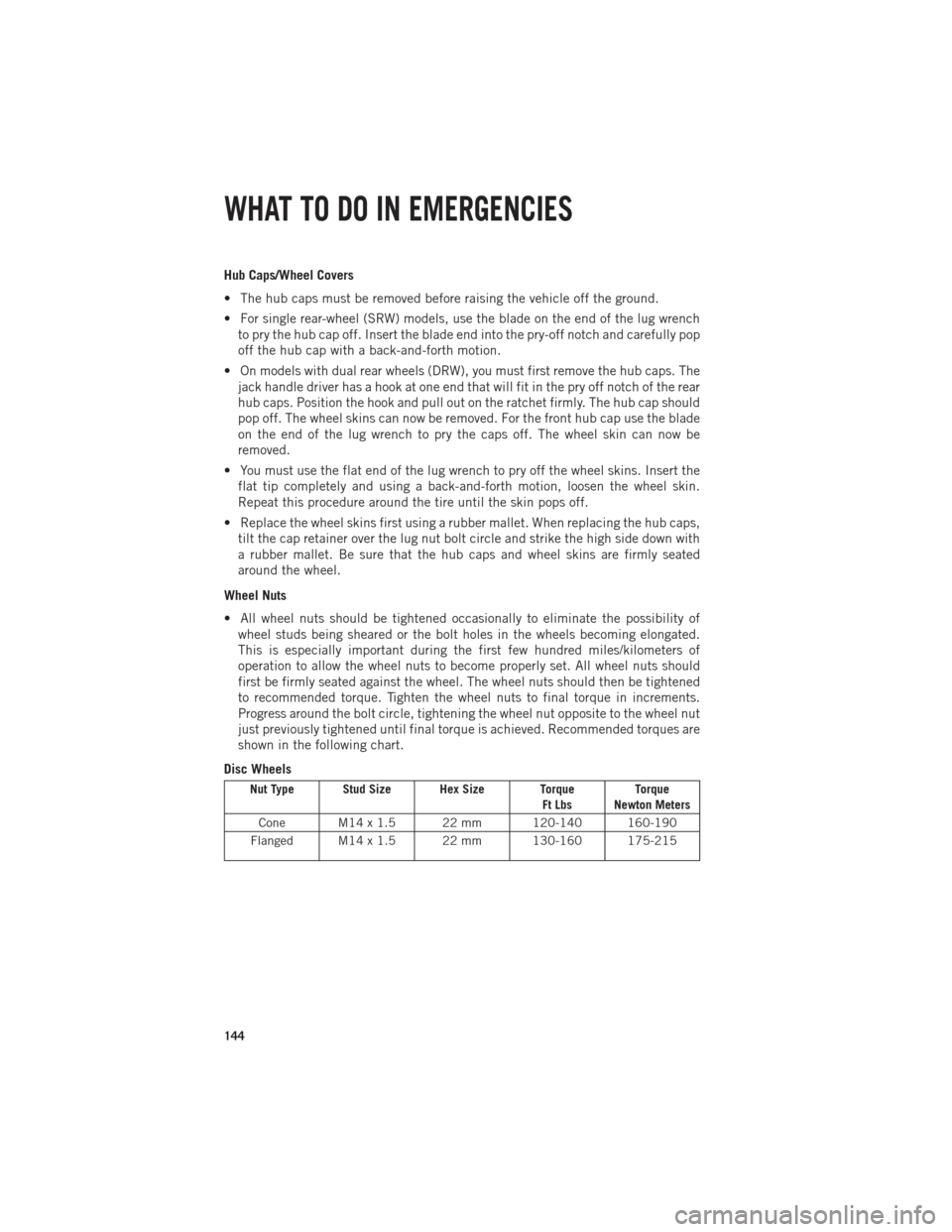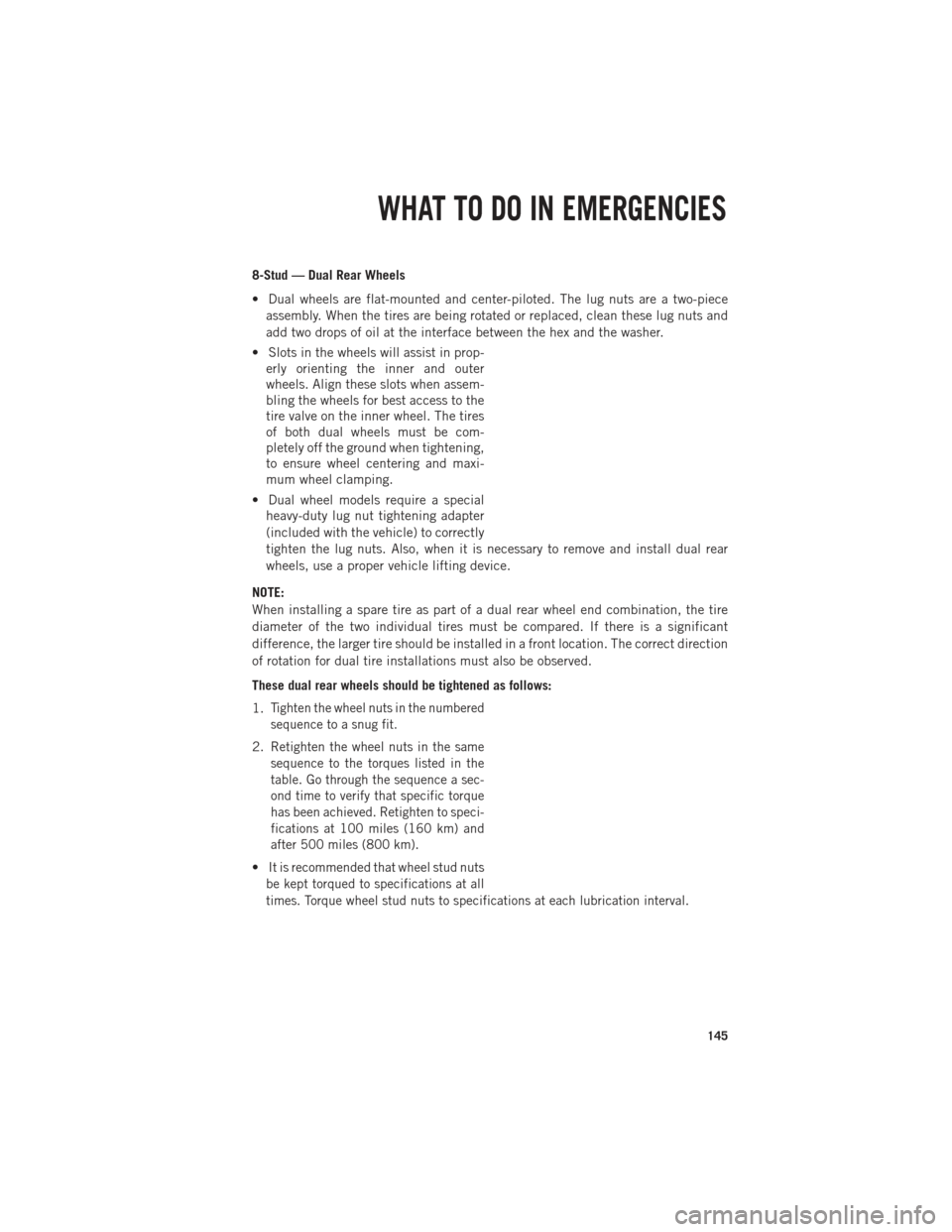ECO mode Ram 1500 2013 Get to Know Guide
[x] Cancel search | Manufacturer: RAM, Model Year: 2013, Model line: 1500, Model: Ram 1500 2013Pages: 196, PDF Size: 9.66 MB
Page 146 of 196

Hub Caps/Wheel Covers
• The hub caps must be removed before raising the vehicle off the ground.
• For single rear-wheel (SRW) models, use the blade on the end of the lug wrenchto pry the hub cap off. Insert the blade end into the pry-off notch and carefully pop
off the hub cap with a back-and-forth motion.
• On models with dual rear wheels (DRW), you must first remove the hub caps. The jack handle driver has a hook at one end that will fit in the pry off notch of the rear
hub caps. Position the hook and pull out on the ratchet firmly. The hub cap should
pop off. The wheel skins can now be removed. For the front hub cap use the blade
on the end of the lug wrench to pry the caps off. The wheel skin can now be
removed.
• You must use the flat end of the lug wrench to pry off the wheel skins. Insert the flat tip completely and using a back-and-forth motion, loosen the wheel skin.
Repeat this procedure around the tire until the skin pops off.
• Replace the wheel skins first using a rubber mallet. When replacing the hub caps, tilt the cap retainer over the lug nut bolt circle and strike the high side down with
a rubber mallet. Be sure that the hub caps and wheel skins are firmly seated
around the wheel.
Wheel Nuts
• All wheel nuts should be tightened occasionally to eliminate the possibility of wheel studs being sheared or the bolt holes in the wheels becoming elongated.
This is especially important during the first few hundred miles/kilometers of
operation to allow the wheel nuts to become properly set. All wheel nuts should
first be firmly seated against the wheel. The wheel nuts should then be tightened
to recommended torque. Tighten the wheel nuts to final torque in increments.
Progress around the bolt circle, tightening the wheel nut opposite to the wheel nut
just previously tightened until final torque is achieved. Recommended torques are
shown in the following chart.
Disc Wheels
Nut Type Stud Size Hex Size Torque Ft LbsTorque
Newton Meters
Cone M14 x 1.5 22 mm 120-140 160-190
Flanged M14 x 1.5 22 mm 130-160 175-215
WHAT TO DO IN EMERGENCIES
144
Page 147 of 196

8-Stud — Dual Rear Wheels
• Dual wheels are flat-mounted and center-piloted. The lug nuts are a two-pieceassembly. When the tires are being rotated or replaced, clean these lug nuts and
add two drops of oil at the interface between the hex and the washer.
• Slots in the wheels will assist in prop- erly orienting the inner and outer
wheels. Align these slots when assem-
bling the wheels for best access to the
tire valve on the inner wheel. The tires
of both dual wheels must be com-
pletely off the ground when tightening,
to ensure wheel centering and maxi-
mum wheel clamping.
• Dual wheel models require a special heavy-duty lug nut tightening adapter
(included with the vehicle) to correctly
tighten the lug nuts. Also, when it is necessary to remove and install dual rear
wheels, use a proper vehicle lifting device.
NOTE:
When installing a spare tire as part of a dual rear wheel end combination, the tire
diameter of the two individual tires must be compared. If there is a significant
difference, the larger tire should be installed in a front location. The correct direction
of rotation for dual tire installations must also be observed.
These dual rear wheels should be tightened as follows:
1.
Tighten the wheel nuts in the numbered
sequence to a snug fit.
2.Retighten the wheel nuts in the same
sequence to the torques listed in the
table. Go through the sequence a sec-
ond time to verify that specific torque
has been achieved. Retighten to speci-
fications at 100 miles (160 km) and
after 500 miles (800 km).
•It is recommended that wheel stud nuts
be kept torqued to specifications at all
times. Torque wheel stud nuts to specifications at each lubrication interval.
WHAT TO DO IN EMERGENCIES
145
Page 156 of 196

FREEING A STUCK VEHICLE
• If your vehicle becomes stuck in mud, sand or snow, it can often be moved by arocking motion. Turn your steering wheel right and left to clear the area around the
front wheels. Then, move the shift lever back and forth between REVERSE and
DRIVE. Using minimal accelerator pedal pressure to maintain the rocking motion,
without spinning the wheels, is most effective.
• Allow the engine to idle with the transmission shift lever in NEUTRAL for at least one minute after every five rocking-motion cycles. This will minimize overheating
and reduce the risk of transmission failure during prolonged efforts to free a stuck
vehicle.
NOTE:
If your vehicle is equipped with Electronic Stability Control (ESC) then press the
"ESC Off" switch, to place the Electronic Stability Control (ESC) system in "Partial
Off" mode, before rocking the vehicle.
CAUTION!
Revving the engine or spinning the wheels too fast may lead to transmission
overheating and failure. It can also damage the tires. Do not spin the wheels above
30 mph (48 km/h) while in gear (no transmission shifting occurring).
WARNING!
Fast spinning tires can be dangerous. Forces generated by excessive wheel speeds
may cause tire damage or failure. A tire could explode and injure someone. Do not
spin your vehicle's wheels faster than 30 mph (48 km/h) when you are stuck. Do
not let anyone near a spinning wheel, no matter what the speed.
WHAT TO DO IN EMERGENCIES
154
Page 164 of 196

FLUIDS AND CAPACITIES
Gasoline Versions
Component Fluid, Lubricant, or Genuine Part Capacities
Engine Coolant
3.6L, 4.7L Engine We recommend you use MOPAR®
Antifreeze/Coolant 10 Year/
150,000 Mile Formula OAT
(Organic Additive Technology). 14 Quarts (13 Liters)
Engine Coolant
5.7L 1500 Models We recommend you use MOPAR
®
Antifreeze/Coolant 10 Year/
150,000 Mile Formula OAT
(Organic Additive Technology). 16 Quarts (15 Liters)
Engine Coolant
5.7L 2500/3500 Models We recommend you use MOPAR
®
Antifreeze/Coolant 10 Year/
150,000 Mile Formula OAT
(Organic Additive Technology) .18.7 Quarts (17.7 Liters)
Engine Coolant
5.7L 2500/3500
Models w/Heavy Duty We recommend you use MOPAR®
Antifreeze/Coolant 10 Year/
150,000 Mile Formula OAT
(Organic Additive Technology) .19.2 Quarts (18.2 Liters)
Engine Oil with Filter 3.6L, 4.7L, 5.7L We recommend you use
API certified 5W-20 engine oil, meeting the requirements ofChrysler Material Standard
MS-6395. Refer to you oil filler cap for correct SAE grade. 3.6L Engine - 6 Quarts
(5.7 Liters)
4.7L Engine - 6 Quarts (5.7 Liters)
5.7L Engine - 7 Quarts (6.6 Liters)
Engine Oil with Filter 5.7L
For 2500/3500 trucksoperating with a gross combined weight
rating greater than
14,000 lbs/(6,350 kg)
We recommend you use
API Certified SAE 5W-30 engine oil, meeting the requirements of Chrysler Material Standard
MS-6395. Refer to your engine oil filter cap for correct SAE grade. 5.7L Engine - 7 Quarts
(6.6 Liters)
Engine Oil Filter
3.6L, 4.7L, 5.7L We recommend you use MOPAR
®
Engine Oil Filters.
—
Spark Plug 3.6L We recommend you use MOPAR®
Spark Plugs. —
Spark Plug 4.7L We recommend you use MOPAR®
Spark Plugs. —
Spark Plug 5.7L We recommend you use MOPAR®
Spark Plugs. —
Automatic
Transmission —
Eight-Speed AutomaticWe recommend you use Mopar®
ZF 8&9 Speed ATF™ Automatic Transmission Fluid. —
MAINTAINING YOUR VEHICLE
162
Page 165 of 196

Component Fluid, Lubricant, or Genuine Part CapacitiesAutomatic
Transmission —
Six-Speed Automatic
with Gasoline Engine We recommend you use MOPAR®
ATF+4 Automatic Transmission
Fluid. —
Manual Transmission G-56 We recommend you use MOPAR
®
ATF+4 Automatic Transmission
Fluid. —
Transfer Case We recommend you use MOPAR
®
BW44–44 Transfer Case Fluid. —
Front Axle 1500
Four-Wheel Drive Models We recommend you use GL-5
SAE 75W-90 MS-9763. —
Rear Axle 1500 Models
We recommend you use MOPAR®
Synthetic Gear Lubricant SAE
75W-140 MS-8985. Limited-Slip Rear Axles require the additionof 118 ml (4 oz) of MOPAR
®
Limited Slip Additive MS-10111. —
Front and Rear Axle 2500/3500 Models We recommend you use
Synthetic, GL-5 SAE 75W-90. Limited-Slip 10.5/11.5 inch
Rear Axles Limited slip additive is not required. —
Brake Master Cylinder We recommend you use MOPAR
®
DOT 3 and SAE J1703. If DOT 3
is not available, then DOT 4 is acceptable. —
Power Steering Reservoir We recommend you use MOPAR
®
Power Steering Fluid +4 or
MOPAR®ATF+4®Automatic
Transmission Fluid. —
Fuel Selection 3.6L, 4.7L 87 Octane1500 Regular
Cab Shortbed/Crew
Quad Cab - 26 Gallons (98 Liters) (Approxi-
mate) 1500 Regular Cab Longbed/Crew
Quad Cab (Optional) -
32 Gallons (121 Liters) (Approximate)
2500/3500 Shortbed -
34 Gallons (129 Liters) (Approximate)
2500/3500 Longbed -
35 Gallons (132 Liters) (Approximate)
MAINTAINING YOUR VEHICLE
163
Page 187 of 196

NOTE:
• A street address is required when ordering manuals (no P.O. Boxes).
• The Owner's Manual and User Guide electronic files are also available on theChrysler, Jeep, Ram Truck and Dodge websites.
• Click on the “For Owners” tab, select “Owner/Service Manuals”, then select your desired model year and vehicle from the drop down lists.
REPORTING SAFETY DEFECTS IN THE UNITED STATES
• If you believe that your vehicle has a defect that could cause a collision or causeinjury or death, you should immediately inform the National Highway Traffic Safety
Administration (NHTSA) in addition to notifying the manufacturer.
• If NHTSA receives similar complaints, it may open an investigation, and if it finds that a safety defect exists in a group of vehicles, it may order a recall and remedy
campaign. However, NHTSA cannot become involved in individual problems
between you, your authorized dealer and the manufacturer.
• To contact NHTSA, you may either call the Auto Safety Hotline toll free at 1–888–327–4236 (TTY: 1–800–424–9153), or go to http://www.safercar.gov; or
write to: Administrator, NHTSA, 1200 New Jersey Avenue, SE., West Building,
Washington, D.C. 20590. You can also obtain other information about motor
vehicle safety from http://www.safercar.gov.
In Canada
• If you believe that your vehicle has a safety defect, you should contact the Customer Service Department immediately. Canadian customers who wish to
report a safety defect to the Canadian government should contact Transport
Canada, Motor Vehicle Defect Investigations and Recalls at 1-800-333-0510 or
go to http://www.tc.gc.ca/eng/roadsafety/safedrivers-childsafety-index-53.htm
• French Canadian customers who wish to report a safety defect to the Canadian government should contact Transport Canada, Motor Vehicle Defect Investigations
and Recalls at 1-800-333-0510 or go to http://www.tc.gc.ca/securiteroutiere/
CUSTOMER ASSISTANCE
185